|
Home
My Trip to Cambodia
By: FrancEs Yee
3rd to 7th June, 2003
Yes, it's another adventure. Where to this time? To the Kingdom of Cambodia!
I'll be writing this page a little differently - journal format - as compared to my other travel stories because there are just too many highlights for a tour of just 5 days! This trip has cost me RM2020 paid in Malaysia which included flight, accomomodation and meals for 5 days and 4 nights. I spent a further USD30 for international flight taxes. My trip covered the city of Phnom Penh (p-nom-pen) and Siem Reap province where the Temples (of Angkor) are.
3 June 2003
Departed for Phnom Penh on a Tuesday morning and arrived one and a half hours later at Pochentong International Airport. We checked-in to the hotel and off we went for a slow drive around the city.
The first place we stopped at was the Tuol Sleng Prison or better known as the S-21 which stands for Security Office 21. Tuol Sleng was earlier a primary school in 1962 which became a major place of torture and death during the Khmer Rouge regime. Classrooms and offices became sites of unspeakable brutalities to the perhaps 20,000 prisoners who passed through its gates; it was one of the most significant centers of the Khmer Rouge system of terror. S-21 is now a museum of genocidal crimes.
After S-21, we then took about an hour's drive to the Killing Fields of Cheung Ek. It was a place where civilians were killed and buried in mass graves. Many of them were transported here after detention and torture in Tuol Sleng. This place is a chilling reminder of the Khmer Rouge regime. In the center of the area is a 17-storey glass stupa which houses more than 8000 skulls exhumed from mass graves. I was told by the guide that every year during the monsoon season, rain will wash the soil away and reveal new skulls and bones, which will then be kept in the stupa. Brrr! And true enough, I saw bits and scraps of buried cloth and bones showing on the grounds we walked on. A word of caution though: Both Tuol Sleng Museum's and the Killing Fields' displays may be disturbing for some and aren't suitable for those who are easily shocked.
The day ended with a lot of thoughts in my mind.
4 June 2003
 Went round the city snapping pictures of some landmarks which included the Independence Monument - decorated with 100 snake heads (left) and made our way to the Royal Palace. The royal residence, set back from the riverfront, was well worth visiting as it was located between the Silver Pagoda and the National Museum. The Silver Pagoda (or the temple of the Emerald Buddha), formerly a wooden building, was rebuiltin 1962 in concrete and marble. The pagoda was floored with over 5000 silver tiles each weighing 1 kg. It was famous for its 90 kg solid gold Buddha and an emerald Buddha said to be made of baccarant crystal. Sharing the pagoda were many other interesting artifacts and jewels and was one of the few temples to remain intact during the Khmer Rouge regime. Photography was not allowed inside. The tour of the Royal Palace and the Silver Pagoda took about an hour and a half with quite a bit of history to remember. Went round the city snapping pictures of some landmarks which included the Independence Monument - decorated with 100 snake heads (left) and made our way to the Royal Palace. The royal residence, set back from the riverfront, was well worth visiting as it was located between the Silver Pagoda and the National Museum. The Silver Pagoda (or the temple of the Emerald Buddha), formerly a wooden building, was rebuiltin 1962 in concrete and marble. The pagoda was floored with over 5000 silver tiles each weighing 1 kg. It was famous for its 90 kg solid gold Buddha and an emerald Buddha said to be made of baccarant crystal. Sharing the pagoda were many other interesting artifacts and jewels and was one of the few temples to remain intact during the Khmer Rouge regime. Photography was not allowed inside. The tour of the Royal Palace and the Silver Pagoda took about an hour and a half with quite a bit of history to remember.
The National Museum was next and it was built in traditional Khmer style. It houses a collection of ancient Khmer archeological, religious, and artistic artifacts, mostly stone statues (either without heads or one of the limbs). There were over 5000 pieces which represents Cambodia's cultural wealth.
Managed to do a bit of shopping at the Central Market which was one of the largest and busiest markets in Phnom Penh. Despite the hot, hot weather, it was surprisingly cool in the building which was of French architecture. The eastern side, which was the main entrance, had many souvenirs from T-shirts to large stone carvings. In the center of the "dome" were the many jewellery stores and precious stone vendors. Quite a bit of electronic goods, silk cloth and bric-a-brac on sale. Most of the items were considerably cheap and we were allowed to bargain a little for the price we were willing to pay. Managed to buy a bracelet made of ruby chips, some silk items and woven mats.
The last itinerary for the day was Wat Phnom temple which was located on a man-made hill 27 meters high in the middle of Phnom Penh. Greens all around, windy and pleasant.
5 June 2003
A very early flight to Siem Reap by President Airlines (has anyone heard of them??) took only a mere 35 minutes. A guide greeted us and since it was too early for a check-in, we were brought to a Khmer Handicraft school to visit. Here, we observed the students experimenting with metal, wood and stones for carving and sculpturing, painting on lacquer wares and other craft work. Before we left the place, we bought quite a bit of silk-woven goods like bags, cushion covers etc. I bought a pair of silk pants.
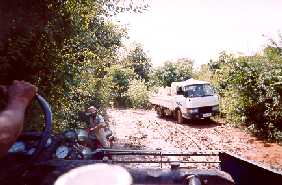 July was supposed to be the start of the monsoon season and since it was a sunny day, the guide decided to do the tour of the floating village on Tonle Sap (tone-lay-saap) river today instead of tomorrow. However, the roads into the village were way too muddy (right) and soft and the car couldn't drive in. We almost turned back and gave this a miss when a big truck from town was making their way into the village. Guess what? July was supposed to be the start of the monsoon season and since it was a sunny day, the guide decided to do the tour of the floating village on Tonle Sap (tone-lay-saap) river today instead of tomorrow. However, the roads into the village were way too muddy (right) and soft and the car couldn't drive in. We almost turned back and gave this a miss when a big truck from town was making their way into the village. Guess what?  Yes, we got daring and adventurous, paid USD1 each and hopped onto the truck together with the locals who were bringing in their market dailies (left). Wow, such a bumpy, rough and hot ride under the sun but hey, this is something that other tour groups wouldn't have experienced! After some difficult maneuvering and about what seemed like 45 minutes later, we arrived at the village (below). Got onto a sampan boat and cruised along the Tonle Sap Great Lake. Discovered the lifestyle of the inhabitants and interestingly, these village people actually move location depending on the season. Yes, we got daring and adventurous, paid USD1 each and hopped onto the truck together with the locals who were bringing in their market dailies (left). Wow, such a bumpy, rough and hot ride under the sun but hey, this is something that other tour groups wouldn't have experienced! After some difficult maneuvering and about what seemed like 45 minutes later, we arrived at the village (below). Got onto a sampan boat and cruised along the Tonle Sap Great Lake. Discovered the lifestyle of the inhabitants and interestingly, these village people actually move location depending on the season. 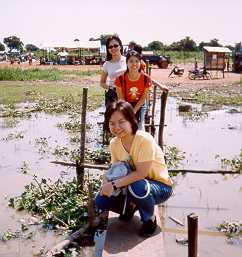
After about an hour later, it was time to get back to Siem Reap but wait a minute! There was no way out because we did not bring a car in! We thought we would wait for another one of those trucks to go out and so we waited. 5 minutes... 10 minutes... 15 minutes... 20 minutes. No truck.
A kind villager approached the guide and asked him in Khmer whether we wanted a boat ride out for USD5. Of course we would and that was exactly what we did! It was not a smooth ride by boat because the waters were shallow and the propellers kept getting stuck in the mud but after more than half an hour, the boat managed to get as close to the bank as possible and then with shoes in our hands and folded jeans above knees, we waded above-ankle deep and made our way to the land. Eww!
We lunched and made a short stop at another smaller Killing Fields which is now a monastery, and proceeded to a Landmine Museum soon after. This museum was founded by a former Khmer Rouge soldier named Aki Ra and it displayed quite a bit of deactivated ordnance.
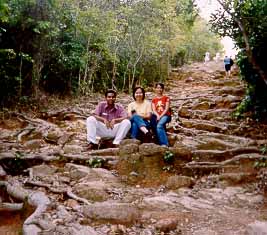 In the late afternoon, we travelled to Phnom Bakheng for a sunset view. Phnom Bakheng is a 65-metre hill (left) and it is the only natural hill in the area. We entered Phnom Bakheng by a steep path and the hill itself was a challenge. Well, though it was easier to climb up than coming back down, I found it quite a task as I was kind of afraid of heights. Apart from this hill without steps, there were 4 further levels of steps before one could reach the top . Those steps were in ruins, steep, narrow in width and high in height. In the late afternoon, we travelled to Phnom Bakheng for a sunset view. Phnom Bakheng is a 65-metre hill (left) and it is the only natural hill in the area. We entered Phnom Bakheng by a steep path and the hill itself was a challenge. Well, though it was easier to climb up than coming back down, I found it quite a task as I was kind of afraid of heights. Apart from this hill without steps, there were 4 further levels of steps before one could reach the top . Those steps were in ruins, steep, narrow in width and high in height. I managed it though not without a slip or two. Thank goodness for the guide who was my constant "hand rail". Well, of all the trouble I took to supposedly see a view of sunset (right), I did not stay long enough for the sun to go down because I wanted to hit the hill downwards before the crowd follows. Aww you know, I was the slow one. *sigh* Useless me... I managed it though not without a slip or two. Thank goodness for the guide who was my constant "hand rail". Well, of all the trouble I took to supposedly see a view of sunset (right), I did not stay long enough for the sun to go down because I wanted to hit the hill downwards before the crowd follows. Aww you know, I was the slow one. *sigh* Useless me...
6 June 2003
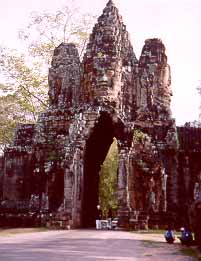 We travelled to the South gate of Bayon, which was within Angkor Thom (left & below). It has a tower with 4 faces pointing in each direction. The one in the picture points South. The Bayon consists of a mass of face-towers and these towers create stone mountains of ascending peaks. Apart from face towers, almost all walls has picture carvings they call "bas-reliefs". Each wall had a story / history of its own to tell. We walked on to the northwest of the Bayon and visited the Bapuon (ba-foon) but since it was going through some restoration work, it was out of bounds. We travelled to the South gate of Bayon, which was within Angkor Thom (left & below). It has a tower with 4 faces pointing in each direction. The one in the picture points South. The Bayon consists of a mass of face-towers and these towers create stone mountains of ascending peaks. Apart from face towers, almost all walls has picture carvings they call "bas-reliefs". Each wall had a story / history of its own to tell. We walked on to the northwest of the Bayon and visited the Bapuon (ba-foon) but since it was going through some restoration work, it was out of bounds. 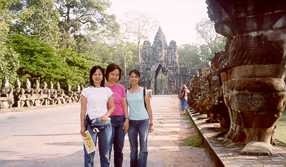 Immediately after the east entrance to the Bapuon starts the Elephant Terrace which was 300 metres long. Beautiful bas-reliefs of elephants along the walls lead you to the Terrace of the Leper King. This terrace is massive and oh, the description is beyond words - the beautiful and clear carvings of mythological scenes showing little figures and marine creatures etc - Awesome! Immediately after the east entrance to the Bapuon starts the Elephant Terrace which was 300 metres long. Beautiful bas-reliefs of elephants along the walls lead you to the Terrace of the Leper King. This terrace is massive and oh, the description is beyond words - the beautiful and clear carvings of mythological scenes showing little figures and marine creatures etc - Awesome!
We drove on next to see the unrestored temple of Ta Prohm (below left). The atmosphere here was quiet and cool, very well shaded and 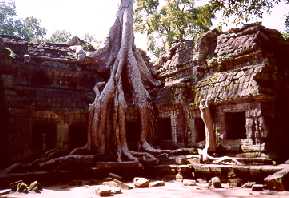 there wasn't much to see around here because the condition was in ruins. Ta Prohm has been (almost) untouched since it was discovered and retains much of its mystery. Ta Prohm is the perfect lost-temple-in-the-jungle. Unlike most of the other monuments at Angkor, it has not been cleared of its undergrowth, fig trees and creepers - one of Angkor's most enchanting temples. Over the years, trees have grown among the ruins and the roots entwined themselves around Ta Prohm. Their roots burst apart even the thickest of walls, yet their clinging embrace prevents the walls from collapsing. Enchanting! there wasn't much to see around here because the condition was in ruins. Ta Prohm has been (almost) untouched since it was discovered and retains much of its mystery. Ta Prohm is the perfect lost-temple-in-the-jungle. Unlike most of the other monuments at Angkor, it has not been cleared of its undergrowth, fig trees and creepers - one of Angkor's most enchanting temples. Over the years, trees have grown among the ruins and the roots entwined themselves around Ta Prohm. Their roots burst apart even the thickest of walls, yet their clinging embrace prevents the walls from collapsing. Enchanting!
For an extra USD10, we requested the guide to bring us to Banteay Srei Temple, another must-see which was about 25 km north of Angkor, which was also well worth the trip. This temple, known as the Temple of Fortress or simply the Ladies Temple contained some of the finest examples of Khmer sculpture. The carvings were exquisite, intricate, fine, rich and deep on pink sandstones. The place gave a certain glow under the morning sun. The doorways are small - only fit for a lady, I suppose. All the buildings around Banteay Srei are covered in carvings: the foliage, the lintels, the balustered windows. Banteay Srei's ornamentation is exceptional - its roofs, pediments and lintels are magnificently carved with tongues of flame, coiling serpents' tails, gods, demons and floral garlands. Mesmerising! 
We saved the best for last - Angkor Wat (right). Magnificent! The layout of Angkor Wat emulates the universe according to Hindu mythology. Surrounded by a moat 500 feet wide which 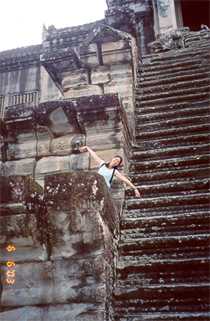 symbolised the first ocean, Angkor Wat's five famous towers rise into the sky, a geometrical arrangement of numerous galleries, adorned with reliefs and the stone images of celestial Apsara dancers, as well as portals, chambers and courtyards. The highest dome which rises at the center, takes about 4 levels of "steps" to reach. symbolised the first ocean, Angkor Wat's five famous towers rise into the sky, a geometrical arrangement of numerous galleries, adorned with reliefs and the stone images of celestial Apsara dancers, as well as portals, chambers and courtyards. The highest dome which rises at the center, takes about 4 levels of "steps" to reach.
The 1st level alone was 13 metres high (left) and the steepness of the ruined steps was about 75 degrees. Look at me. I have never done so much dangerous climbing in my life before. There weren't even hand rails for support. Just bare stones. Maybe in the years to come, there will be safety measures. Why is there so much climbing, you may ask yourself? Well, in ancient times, temples were heaven - and the way to heaven was not easy (it still isn't). The tour around Angkor Wat took a full 3 hours.
7 June 2003
We bade Siem Reap goodbye and flew President Airlines once again, back to Phnom Penh domestic airport. We had a good 6 hours before our international flight back to KL and we took this time to do a bit of last minute shopping. We went to the Russian Market this time and spent about an hour there. After that, we re-visited the Central Market to get whatever stuff we thought was worth spending money on. Just before we adjourned to the airport, our guide took us to a local Khmer restaurant for lunch. The setting was pleasant and windy, overlooking the Mekong river. There were many hammocks around for the local people to laze around in. Our orders did take a long while to come and we discovered that their lunch breaks are normally 3 hours long. No wonder!
Cambodia tour was, to me, a lot of geography, history and culture. In fact, too much of it - I had information overload. Oh yes, and a lot of stones too but I was so awed by them that I am sure this trip has been AN experience of a lifetime. Of course one can always go again but the fact that it is still pretty unpolished left it quite in its original state and all the more, one should visit now. The weather was very hot indeed though it is the start of the monsoon season but if I were to recommend a time to visit, the middle of the monsoon season would be nice when the lake or river and moat are full. Food was very, very good. It's a mix of Chinese-Vietnamese or Chinese-Thai. My favourite has to be the Banh Xeo (ban-chiau), known as the crunchy yellow cake in English.  It's a big crispy dough with minced meat and bean sprouts in the middle, eaten wrapped with lettuce with a dip of sweet and sour sauce. Yummy! And oh, I must let you know that I ate one miserable roasted cricket but hey, I tried a cricket! Look at the picture (right), look! I tried the one on the extreme left. Sheesh! They eat roasted insects like how you would eat peanuts actually, and the taste? Like fried prawns. Should I say "yum"? *silly grin* It's a big crispy dough with minced meat and bean sprouts in the middle, eaten wrapped with lettuce with a dip of sweet and sour sauce. Yummy! And oh, I must let you know that I ate one miserable roasted cricket but hey, I tried a cricket! Look at the picture (right), look! I tried the one on the extreme left. Sheesh! They eat roasted insects like how you would eat peanuts actually, and the taste? Like fried prawns. Should I say "yum"? *silly grin*
Many of the locals thought that I was one of them: A Khmer. Hmm, could it be my dark olive skin? Could it be my hair? Could it be my features? Ah, an exotic beauty, I am! Tee hee! Well friends, Cambodia's main highlight has to be Angkor Wat. It is one of the wonders of the modern world. So what are you waiting for?
Till I go somewhere again - Tata!
Love,
|

